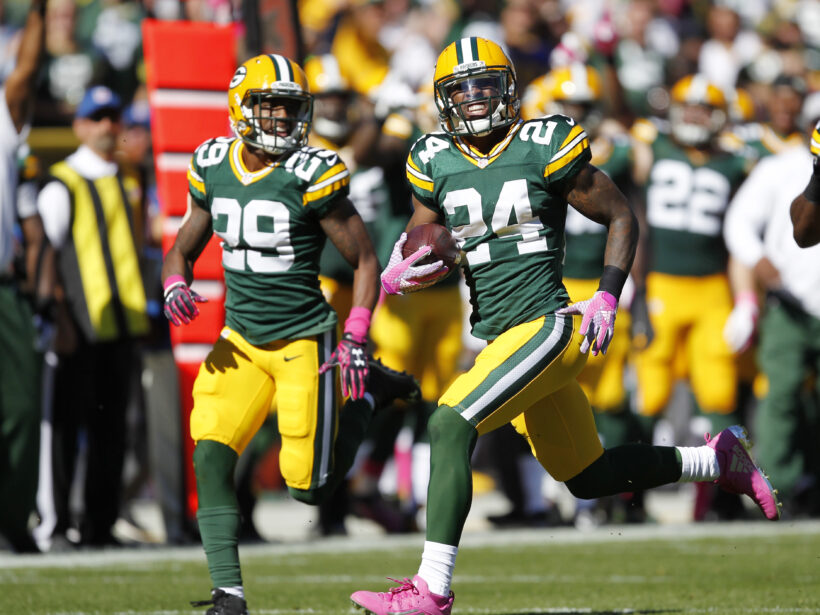Casey Hayward is set to become an unrestricted free agent as soon as the new league year begins on Mar. 9 and whether or not he should continue to be a member of the Green Bay Packers secondary is debatable.
The four-year veteran and 62nd overall pick in the 2012 NFL Draft has played out his rookie contract and one could argue that he exceeded expectations for a second-round selection. As a rookie, he led the team with six interceptions and 21 passes defensed.
Plagued by a hamstring injury in 2013, he played only three games in his second season but followed it up with three interceptions in 2014, showing signs of being the defensive ball magnet he was labeled as after his impressive rookie campaign.
But after general manager Ted Thompson let Tramon Williams and Davon House walk in free agency last offseason, the Packers retooled at cornerback with their first two selections of the 2015 Draft. First rounder Damarious Randall quickly became the full-time starter opposite of Sam Shields.
Quinten Rollins, Thompson’s second round pick of 2015, is entering just his third year of football as he famously started his collegiate career as a senior at Miami (Ohio) after playing basketball there for four seasons. In that single season, Rollins was the MAC Defensive Player of the Year.
So with that level of investment in Randall and Rollins, coupled with the virtual certainty that Shields will remain the team’s top corner, one of the more intriguing decisions Thompson will have to make this March is whether or not to bring Hayward back to a seemingly loaded secondary or, as often is the case, let the young players assume greater roles and grow from within.
Clearly, Rollins is still raw. But his role increased as the season went on due to injuries that kept Micah Hyde and Shields out of action in the second half of the year.
Hayward played primarily in the slot, so should he depart, that seems like the most logical fit for Rollins on paper. But Rollins isn’t exclusively a nickel cornerback.
Rollins saw 44 targets in 2015-16, including the Packers two playoff games. Targets in this case are a bit subjective, as they were not only man coverage situations but also instances in which it was obvious that a receiver was Rollins’ responsibility in zone coverage. Here is how and where they shook out:
| Left CB | Slot Left CB | Slot Right CB | Right CB | |
| Comp/att | 7/16 (43.7%) | 3/5 (60%) | 5/11 (45.4%) | 7/12 (58.33%) |
| Yds per rec | 12.75 ypc | 15 ypc | 19.6 ypc | 13.5 ypc |
| Yds per att | 5.5 yds per att | 9 yds per att | 8.9 yds per att | 7.9 yds per att |
| INT | 0 | 1 | 1 | 0 |
Totals allowed: 22/44 (50% completed), 329 yds, 14.9 yards per catch, 7.47 yards per attempt, 2 INT (1 TD)
So what do the numbers tell us? Not much of anything.
Of the 44 targets charted, it’s really hard to decipher whether or not Rollins would be more successful as a nickel corner or a boundary corner.
Apart from the sample size being small, it’s hard to make a strong determination of what Rollins is or could be because you simply cannot block out the fact that a fairly productive rookie season was just his second playing a high level of football. That’s why as outsiders, we’re merely guessing what it is that Thompson, Dom Capers and his defensive assistants like or don’t like about him.
There are glimpses of him playing on the boundary and taking receivers like Michael Crabtree out of the game in Oakland. There are flashes of exceptional instincts in zone schemes that can be likened to Hayward’s “nose for the ball.” There’s also tape of speed receivers like Stedman Bailey giving him trouble out of the slot.
In general, Rollins is an exciting prospect because of the unknown and the untapped. That’s what makes it hard to think that another year under cornerbacks coach Joe Whitt Jr. won’t yield big rewards. Whitt, as Kevin Clark of the Wall Street Journal wrote in January, prefers his players with limited experience so that he doesn’t have to “un-coach” any bad habits. It worked with Sam Shields, who played wide receiver at the University of Miami for the better portion of his career and, as a result, went undrafted. He was a physical talent with no position. Rollins’ only true experience at a position is at point guard.
In today’s NFL, there certainly is no harm in having depth at cornerback and reflecting on 2015, it was likely the deepest position for the Packers out of any on their roster. They endured injuries to their two starters, as well as injuries at safety that impacted which player lined up where. And for the most part, they held strong.
But depending on Hayward’s price tag, the fit may not be there for him to return to Green Bay for his second contract at the prime age of 26.
It’s hard to have a strong opinion one way or another on how damaging that could be. We just simply haven’t seen enough of Rollins.
But that, like guessing whether or not Rollins will be the newest Packer to shine in their “next man up” system, is the fun of it.


1 response to “Hayward’s Future Hinges on Packers Faith in Rollins”
Of course Haywards future depends on the teams belief in Rollins. And that spells a new address for Hayward! More a statement of fact than a question worth discussing.